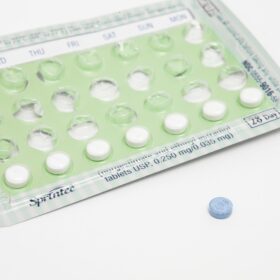
Contraceptive effectiveness explained
When discussing how effective contraception is, we use the terms perfect and typical use.
‘Typical use’ is what we think of as real-world use and is what we care about most. This includes all the pregnancies which happened when people were using contraception regardless of how reliably they were taking them.
‘Perfect use’ is what we see in clinical trials where researchers prompted participants to take the contraceptives exactly how and when they should. As real-life humans, it is unlikely we will use a method 100% perfectly all the time.
Typical use probably overestimates risk for people who are reliable at using their contraceptive method. Perfect use can give false assurance of how effective a method is. In reality, the true effectiveness of contraception probably sits in between these statistics.
The more reliably you take a medication, the more likely it is to work. If you forget pills or miss the right windows for taking, it becomes less dependable.
Our missed pill calculator can help work out what you need to minimise the risk of pregnancy if you have a slip-up. Remember, very few people will take a pill perfectly, but many will take it reliably.
Long-acting contraception like implants, injections and coils have minimal ‘user- error’, which means that the typical and perfect use are very similar. A slight difference represents people forgetting to renew a method of contraception, and it then expires.
The table below shows the % of women experiencing an unintended pregnancy during the first year of typical and perfect use of that method of contraception.
So if you followed 100 individuals who used the combined pill typically for a year, 9 would get pregnant.
This table contains estimates based on available data. These may differ between studies or change slightly as studies are repeated or updated.
| Contraceptive method | Typical use | Perfect use |
|---|---|---|
| Implant | 0.05% | 0.05% |
| Male vasectomy | 0.15% | 0.1% |
| Hormonal IUD | 0.2-0.3% | 0.2-0.3% |
| Female sterilisation | 0.5% | 0.5% |
| Copper IUD | 0.8% | 0.6% |
| Copper Ballerine IUB | 0.8% | 0.6% |
| Injection | 6% | 0.2% |
| Natural cycles | 7% | 2% |
| Combined hormonal contraception (pill, patch, ring) | 9% | 0.3% |
| Progestogen-only pill (‘mini pill’) | 9% | 0.3% |
| Male condom | 18% | 2% |
| Diaphragm | 12% | 6% |
| Female condom | 21% | 5% |
| Fertility Awareness Method (FAM) | 24% | 0.4-5% |
| Withdrawal (pull out) | 20% | 4% |
| No contraception | 85% | 85% |
A note on the hormonal coil (IUS):
- Studies suggest that contraceptive failure during licensed use is around 0.2% for 52mg levonorgestrel containing devices and 0.3% for the 19.5 mg and 13.5 mg devices.
A note on Fertility Awareness Methods (FAM):
- The efficacy of FAM is very difficulty to ascertain
- Typical use with a single fertility indicator such as the ovulation method at 1 year is around 24%
- However individuals using fertility awareness with a combination of fertility indicators tend to show higher levels of motivation resulting in higher efficacy
- The Symptothermal method is a double-check method based on evaluation of cervical mucus to determine the first fertile day and evaluation of cervical mucus and temperature to determine the last fertile day
- Perfect use of the symptothermal method at 1 year has a 0.4% failure rate.
- The effectiveness for the Natural Cycles app is self-reported from their website.
A note on withdrawal (pull out) method:
- The withdrawal method relies on removing the penis all the way out of the vagina before ejaculation occurs during sex. It is not considered a reliable method of contraception on its own.
Our medical review process
This article has been medically reviewed for factual and up to date information by a Lowdown doctor.






